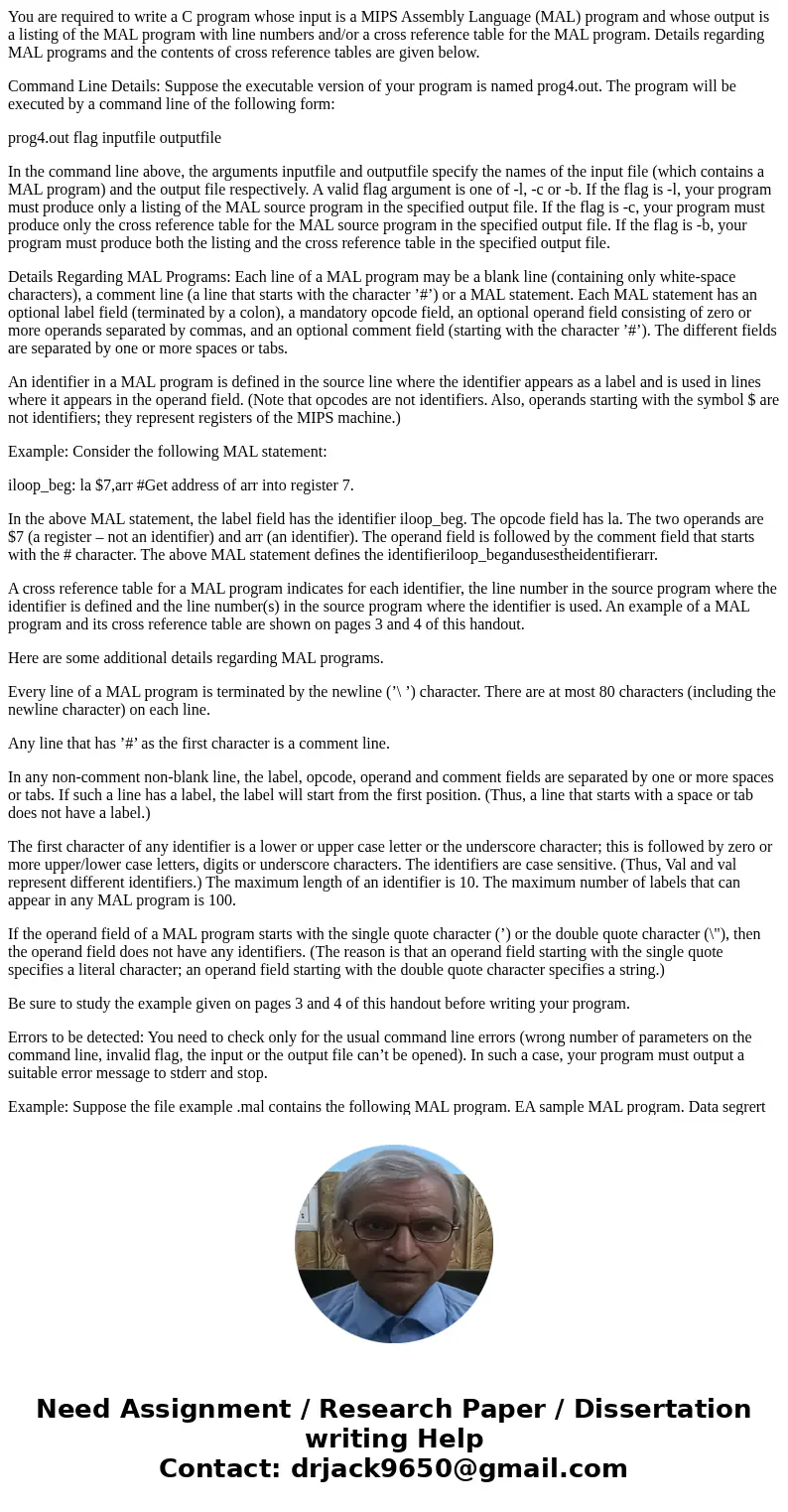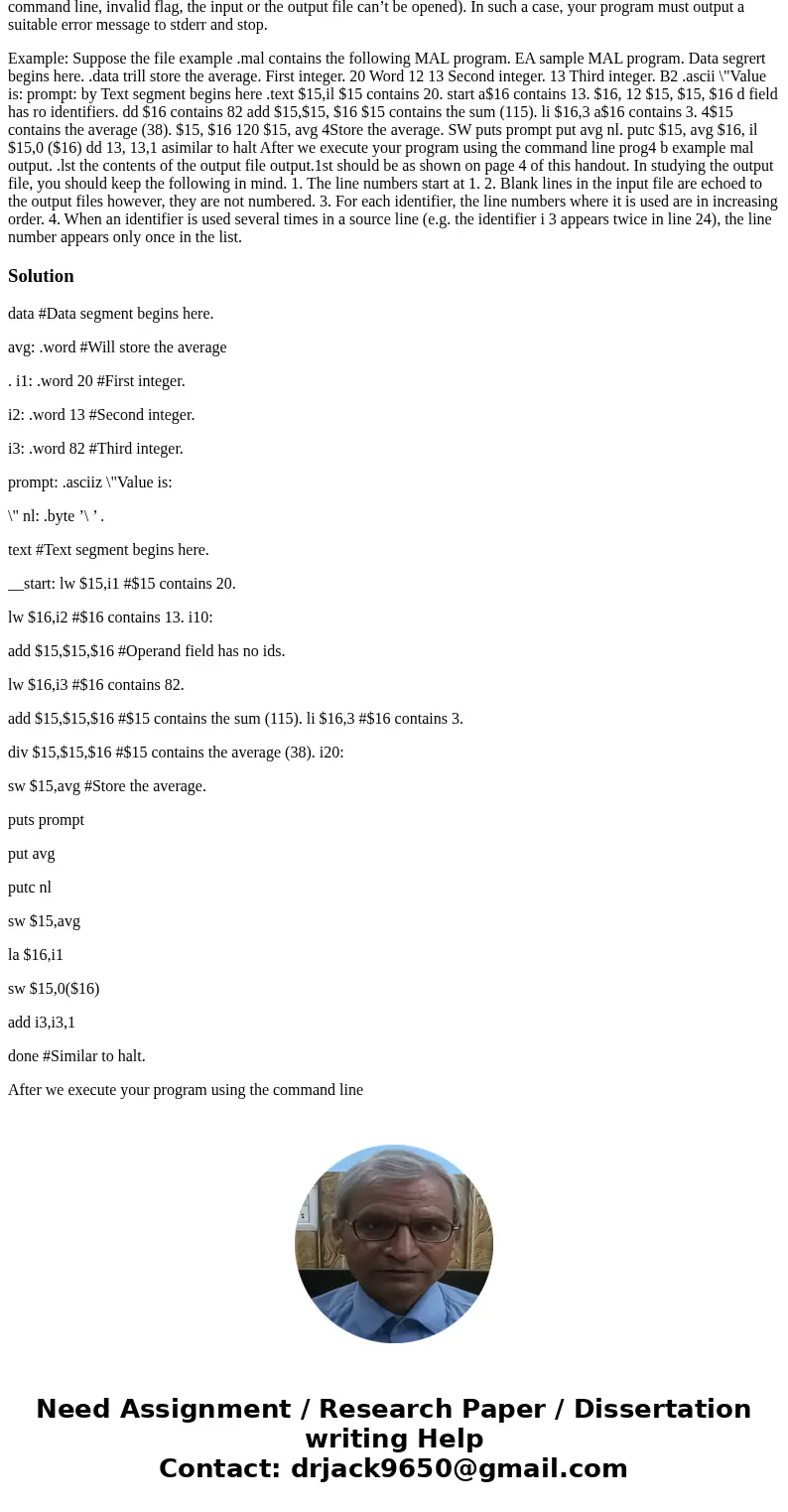You are required to write a C program whose input is a MIPS
You are required to write a C program whose input is a MIPS Assembly Language (MAL) program and whose output is a listing of the MAL program with line numbers and/or a cross reference table for the MAL program. Details regarding MAL programs and the contents of cross reference tables are given below.
Command Line Details: Suppose the executable version of your program is named prog4.out. The program will be executed by a command line of the following form:
prog4.out flag inputfile outputfile
In the command line above, the arguments inputfile and outputfile specify the names of the input file (which contains a MAL program) and the output file respectively. A valid flag argument is one of -l, -c or -b. If the flag is -l, your program must produce only a listing of the MAL source program in the specified output file. If the flag is -c, your program must produce only the cross reference table for the MAL source program in the specified output file. If the flag is -b, your program must produce both the listing and the cross reference table in the specified output file.
Details Regarding MAL Programs: Each line of a MAL program may be a blank line (containing only white-space characters), a comment line (a line that starts with the character ’#’) or a MAL statement. Each MAL statement has an optional label field (terminated by a colon), a mandatory opcode field, an optional operand field consisting of zero or more operands separated by commas, and an optional comment field (starting with the character ’#’). The different fields are separated by one or more spaces or tabs.
An identifier in a MAL program is defined in the source line where the identifier appears as a label and is used in lines where it appears in the operand field. (Note that opcodes are not identifiers. Also, operands starting with the symbol $ are not identifiers; they represent registers of the MIPS machine.)
Example: Consider the following MAL statement:
iloop_beg: la $7,arr #Get address of arr into register 7.
In the above MAL statement, the label field has the identifier iloop_beg. The opcode field has la. The two operands are $7 (a register – not an identifier) and arr (an identifier). The operand field is followed by the comment field that starts with the # character. The above MAL statement defines the identifieriloop_begandusestheidentifierarr.
A cross reference table for a MAL program indicates for each identifier, the line number in the source program where the identifier is defined and the line number(s) in the source program where the identifier is used. An example of a MAL program and its cross reference table are shown on pages 3 and 4 of this handout.
Here are some additional details regarding MAL programs.
Every line of a MAL program is terminated by the newline (’\ ’) character. There are at most 80 characters (including the newline character) on each line.
Any line that has ’#’ as the first character is a comment line.
In any non-comment non-blank line, the label, opcode, operand and comment fields are separated by one or more spaces or tabs. If such a line has a label, the label will start from the first position. (Thus, a line that starts with a space or tab does not have a label.)
The first character of any identifier is a lower or upper case letter or the underscore character; this is followed by zero or more upper/lower case letters, digits or underscore characters. The identifiers are case sensitive. (Thus, Val and val represent different identifiers.) The maximum length of an identifier is 10. The maximum number of labels that can appear in any MAL program is 100.
If the operand field of a MAL program starts with the single quote character (’) or the double quote character (\"), then the operand field does not have any identifiers. (The reason is that an operand field starting with the single quote specifies a literal character; an operand field starting with the double quote character specifies a string.)
Be sure to study the example given on pages 3 and 4 of this handout before writing your program.
Errors to be detected: You need to check only for the usual command line errors (wrong number of parameters on the command line, invalid flag, the input or the output file can’t be opened). In such a case, your program must output a suitable error message to stderr and stop.
Example: Suppose the file example .mal contains the following MAL program. EA sample MAL program. Data segrert begins here. .data trill store the average. First integer. 20 Word 12 13 Second integer. 13 Third integer. B2 .ascii \"Value is: prompt: by Text segment begins here .text $15,il $15 contains 20. start a$16 contains 13. $16, 12 $15, $15, $16 d field has ro identifiers. dd $16 contains 82 add $15,$15, $16 $15 contains the sum (115). li $16,3 a$16 contains 3. 4$15 contains the average (38). $15, $16 120 $15, avg 4Store the average. SW puts prompt put avg nl. putc $15, avg $16, il $15,0 ($16) dd 13, 13,1 asimilar to halt After we execute your program using the command line prog4 b example mal output. .lst the contents of the output file output.1st should be as shown on page 4 of this handout. In studying the output file, you should keep the following in mind. 1. The line numbers start at 1. 2. Blank lines in the input file are echoed to the output files however, they are not numbered. 3. For each identifier, the line numbers where it is used are in increasing order. 4. When an identifier is used several times in a source line (e.g. the identifier i 3 appears twice in line 24), the line number appears only once in the list.Solution
data #Data segment begins here.
avg: .word #Will store the average
. i1: .word 20 #First integer.
i2: .word 13 #Second integer.
i3: .word 82 #Third integer.
prompt: .asciiz \"Value is:
\" nl: .byte ’\ ’ .
text #Text segment begins here.
__start: lw $15,i1 #$15 contains 20.
lw $16,i2 #$16 contains 13. i10:
add $15,$15,$16 #Operand field has no ids.
lw $16,i3 #$16 contains 82.
add $15,$15,$16 #$15 contains the sum (115). li $16,3 #$16 contains 3.
div $15,$15,$16 #$15 contains the average (38). i20:
sw $15,avg #Store the average.
puts prompt
put avg
putc nl
sw $15,avg
la $16,i1
sw $15,0($16)
add i3,i3,1
done #Similar to halt.
After we execute your program using the command line


 Homework Sourse
Homework Sourse